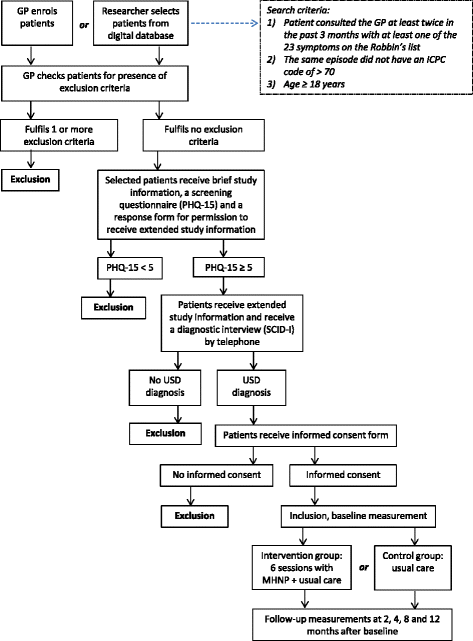The CIPRUS study, a nurse-led psychological treatment for patients with undifferentiated somatoform disorder in primary care: study protocol for a randomised controlled trial
- PMID: 28468642
- PMCID: PMC5414236
- DOI: 10.1186/s13063-017-1951-2
The CIPRUS study, a nurse-led psychological treatment for patients with undifferentiated somatoform disorder in primary care: study protocol for a randomised controlled trial
Abstract
Background: Up to a third of patients presenting medically unexplained physical symptoms in primary care may have a somatoform disorder, of which undifferentiated somatoform disorder (USD) is the most common type. Psychological interventions can reduce symptoms associated with USD and improve functioning. Previous research has either been conducted in secondary care or interventions have been provided by general practitioners (GPs) or psychologists in primary care. As efficiency and cost-effectiveness are imperative in primary care, it is important to investigate whether nurse-led interventions are effective as well. The aim of this study is to examine the effectiveness and cost-effectiveness of a short cognitive behavioural therapy (CBT)-based treatment for patients with USD provided by mental health nurse practitioners (MHNPs), compared to usual care.
Methods: In a cluster randomised controlled trial, 212 adult patients with USD will be assigned to the intervention or care as usual. The intervention group will be offered a short, individual CBT-based treatment by the MHNP in addition to usual GP care. The main goal of the intervention is that patients become less impaired by their physical symptoms and cope with symptoms in a more effective way. In six sessions patients will receive problem-solving treatment. The primary outcome is improvement in physical functioning, measured by the physical component summary score of the RAND-36. Secondary outcomes include health-related quality of life measured by the separate subscales of the RAND-36, somatization (PHQ-15) and symptoms of depression and anxiety (HADS). Problem-solving skills, health anxiety, illness perceptions, coping, mastery and working alliance will be assessed as potential mediators. Assessments will be done at 0, 2, 4, 8 and 12 months. An economic evaluation will be conducted from a societal perspective with quality of life as the primary outcome measure assessed by the EQ-5D-5L. Health care, patient and lost productivity costs will be assessed with the Tic-P.
Discussion: We expect that the intervention will improve physical functioning and is cost-effective compared to usual care. If so, more patients might successfully be treated in general practice, decreasing the number of referrals to specialist care.
Trial registration: Dutch Trial Registry, identifier: NTR4686 , Registered on 14 July 2014.
Keywords: Cost-effectiveness; General practice; Medically unexplained physical symptoms; Primary care; Problem-solving treatment (PST); Undifferentiated somatoform disorder.
Figures
Similar articles
-
Effectiveness of a cognitive behavioural intervention for patients with undifferentiated somatoform disorder: Results from the CIPRUS cluster randomized controlled trial in primary care.J Psychosom Res. 2019 Dec;127:109745. doi: 10.1016/j.jpsychores.2019.109745. Epub 2019 Jun 24. J Psychosom Res. 2019. PMID: 31285038 Clinical Trial.
-
Behavioural modification interventions for medically unexplained symptoms in primary care: systematic reviews and economic evaluation.Health Technol Assess. 2020 Sep;24(46):1-490. doi: 10.3310/hta24460. Health Technol Assess. 2020. PMID: 32975190 Free PMC article.
-
A brief cognitive behavioural intervention is cost-effective for primary care patients with medically unexplained physical symptoms compared to usual care.J Psychosom Res. 2020 Nov;138:110217. doi: 10.1016/j.jpsychores.2020.110217. Epub 2020 Aug 27. J Psychosom Res. 2020. PMID: 32920476
-
Clinical and cost-effectiveness of computerised cognitive behavioural therapy for depression in primary care: design of a randomised trial.BMC Public Health. 2008 Jun 30;8:224. doi: 10.1186/1471-2458-8-224. BMC Public Health. 2008. PMID: 18590518 Free PMC article. Clinical Trial.
-
The efficacy of cognitive behavioural therapy in somatoform disorders and medically unexplained physical symptoms: A meta-analysis of randomized controlled trials.J Affect Disord. 2019 Feb 15;245:98-112. doi: 10.1016/j.jad.2018.10.114. Epub 2018 Oct 22. J Affect Disord. 2019. PMID: 30368076
Cited by
-
Management of patients with persistent medically unexplained symptoms: a descriptive study.BMC Fam Pract. 2018 Jun 18;19(1):88. doi: 10.1186/s12875-018-0791-9. BMC Fam Pract. 2018. PMID: 29914406 Free PMC article.
References
Publication types
MeSH terms
Associated data
LinkOut - more resources
Full Text Sources
Other Literature Sources
Research Materials


